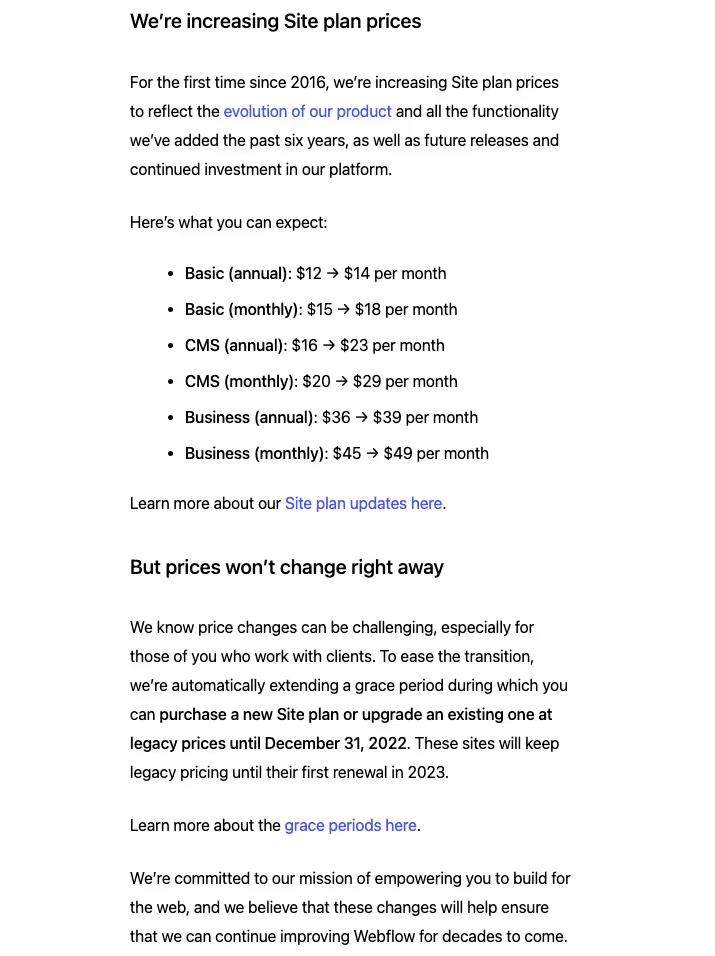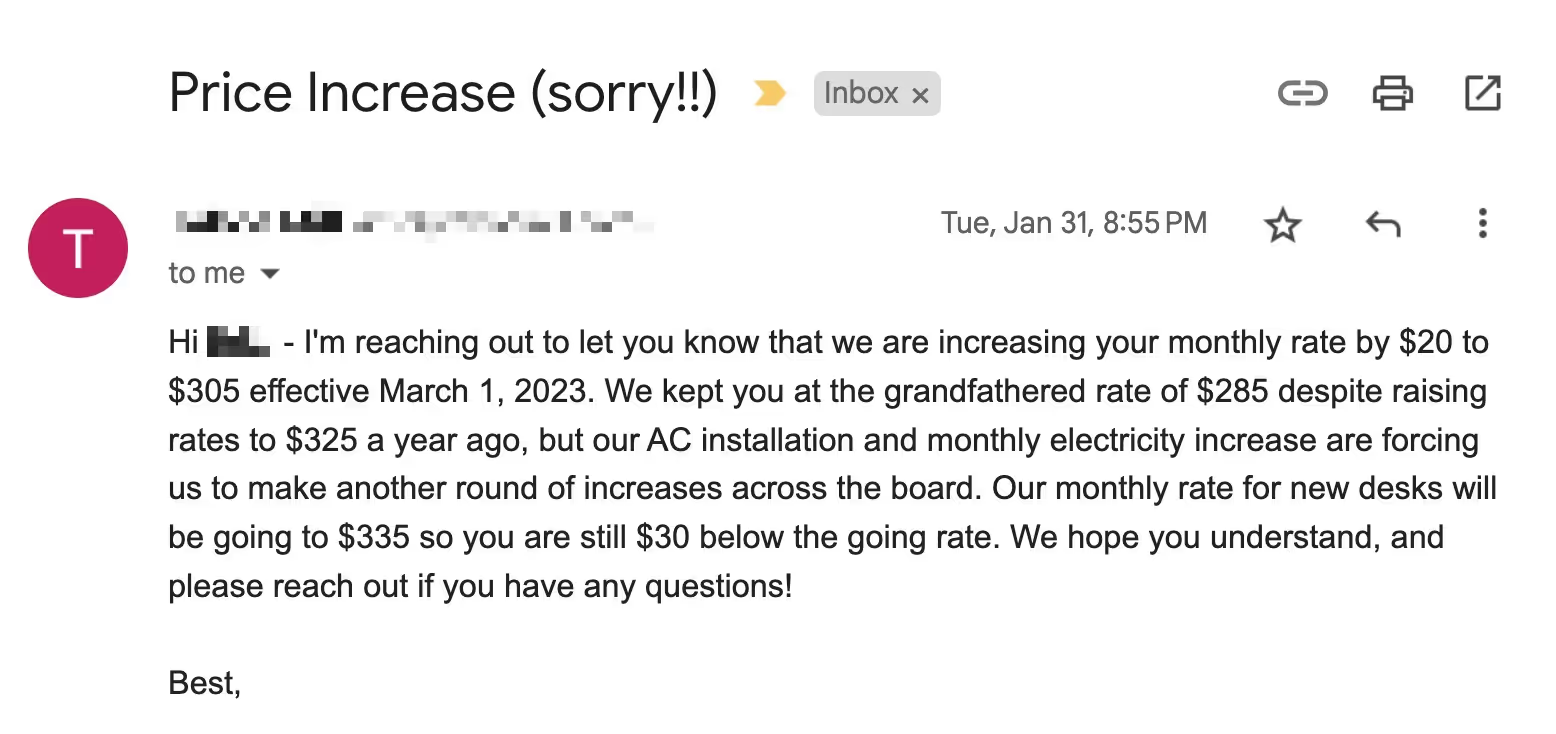Email deliverability: Complete guide + best practices
A complete guide to improving your email deliverability rate and keeping your emails out of the spam folder.
Nobody likes price hikes – not you, not us, certainly not your customers.
From a business perspective, we understand the concern. Talking about price increases can feel like walking on eggshells as you ponder whether customers you've worked so hard to win over might be tempted to explore more wallet-friendly alternatives.
In today's competitive marketplace, where customers can switch brands with a click, navigating a price increase can be quite the balancing act. But fear not, it's all about clear, empathetic communication.
We're here to guide you through that process so you can raise prices without raising eyebrows.
<a href="#raise-prices" class="anchor-link">Why do companies raise prices?</a>
<a href="#easing-concern" class="anchor-link">Easing the concern around raising prices</a>
<a href="#price-without-losing" class="anchor-link">How to raise your prices without losing customers</a>
<a href="#streak-email" class="anchor-link">Communicating price increases over email with Streak</a>
<div class="anchor-wrapper"><div id="raise-prices" class="anchor-target"></div></div>
When they learn about price increases, consumers’ biggest question is, “why?”. There’s no single answer, though. Businesses change their prices for many reasons that they may or may not communicate to customers.
Some of the common reasons companies raise prices include:
Having a clear understanding of why you’re raising your prices will help you communicate changes with your customers in an honest and effective way.
<div class="anchor-wrapper"><div id="easing-concern" class="anchor-target"></div></div>
Many business leaders hesitate to raise prices—even when it’s in the best interest of their companies—because they fear backlash from customers who might be tempted to explore more wallet-friendly alternatives.
But is that concern entirely warranted?
Sure, no one likes to hear that they have to pay more for products or services, so some customers are bound to be upset. In fact, a portion may even try to find a cheaper alternative. But if you approach your price increase the right way, those customers will be in the minority.
Try flipping the script and think about the last time you learned that a product or service you use was going up in price. Were you furious? Did you immediately stop shopping with that company and run to one of its competitors? Probably not. As consumers, a lot of us understand that pricing isn’t set in stone due to the reasons listed above. The important part is that consumers understand why a price raise is happening and believe that it’s either necessary or reflecting an increase in value.
Don’t let the fear of angering some customers prevent you from implementing necessary changes in your business, including price increases. Most companies change their prices at some point—it’s all about communicating that price increase effectively to keep backlash to a minimum.
With a clear strategy for raising prices, you’ll be prepared to break the news and implement the price change without losing customers. If you get a few negative reactions, which you undoubtedly will, you’ll also be better equipped to handle them as they come.
<div class="anchor-wrapper"><div id="price-without-losing" class="anchor-target"></div></div>
It’s true that raising prices introduces you to the risk of losing some customers who are very price-sensitive. However, when done correctly, you may be surprised by how smoothly the whole thing goes over.
The key to raising prices without losing many customers is communicating this change well.
Here’s how to do it.
<div class="anchor-wrapper"><div id="good-reason" class="anchor-target"></div></div>
Many companies are currently increasing their prices “because they can." Businesses see other brands responding to inflation and increased costs and they want a piece of the pie.
While no one can stop you from raising prices just because you want to make more money, that’s not the message you want to send to consumers. Try to increase prices only when you have a good and legitimate reason. Customers will be much more willing to accept price increases when you can back them and clearly explain the “why” behind the decision.

Nocs Provisions, a popular binocular company, cites well-known supply chain challenges and also reiterates the value provided in free shipping, service, and warranties to explain its price increase. By reinforcing that they have their customers’ backs long term, they’re building the relationship even during a price increase.
<div class="anchor-wrapper"><div id="price-increase" class="anchor-target"></div></div>
So you’ve decided a price increase is necessary, but there’s still the question of how much to increase the cost of your product or service.
You don’t want to have to increase prices again right after this initial price raise, so you need to make sure it’s a meaningful increase for your business, but you also don’t want to send your customers into shock. Again - it’s a delicate balance.
To start, consider all the factors that are causing you to raise prices and research other companies in the industry. For example:
With pricing, it’s best to have a clear and strategic approach, versus relying on a “gut feeling” or thinking that a certain number “just sounds right.” Take the time to understand the factors causing your price increase and how much you should charge based on each of them.
While you don’t need to break down your balance sheet with customers, being able to communicate the big picture reasons behind price changes will go a long way to maintain your customer loyalty.
<div class="anchor-wrapper"><div id="advance-notice" class="anchor-target"></div></div>
Suddenly springing a price increase on your customers out of nowhere is a great way to damage their trust in your business. Give your customers plenty of advance notice before the price change so they can adjust. Some may use that time to research alternative solutions, but that risk is worth keeping your customers’ trust. Include the date of the price change in your alert as well as any deadlines to make changes to their service plan or orders if possible.

In their price increase email, Webflow provides plenty of advance notice of the price increase and even offers a grace period for customers to purchase at legacy prices. The grace period gives customers more time to adjust and encourages them to stick with this company.
<div class="anchor-wrapper"><div id="be-concise" class="anchor-target"></div></div>
Your message alerting customers about the price increase doesn’t need to go into the nitty-gritty details about your business. Lengthy explanations won’t make your customers any happier, but they will make your business look somewhat defensive.
Stick to the core details about your new pricing structure, such as the new prices and when they take effect. If you want to add more, consider assuring customers that you’ll continue delivering the products or services they know and love and possibly even improve them.
Here’s a general guideline for what to include in price increase emails:

Strava missed a few key elements when they announced their price increase. They had a great subject line (not pictured) of “Our prices are changing - here’s why”, but the body of the email says very little about the price change. In fact, it doesn’t even tell the recipient if they’re going to see a price raise or when they're raising prices.
<div class="anchor-wrapper"><div id="no-apology" class="anchor-target"></div></div>
You may be tempted to apologize for increasing your prices. Many businesses include a brief apology with the notice of their price increase, but that’s unnecessary. In fact, it may indicate to your customers that there’s wiggle room in your new prices, which you want to avoid. Instead, simply inform customers of the change and leave it at that.

This co-working space recently raised prices and included important information concisely, but apologetically. The language, while it gets the message across, should be more definitive and confident.
<div class="anchor-wrapper"><div id="streak-email" class="anchor-target"></div></div>
Businesses that make price increase announcements often use email to do so since it’s an efficient and affordable method of communicating at scale.
The main issue with sending the announcement over email is that it can come off as impersonal and cold. It doesn’t have to be that way, though. Using a mail merge tool in Gmail, you can send personalized mass emails to alert customers that you’re changing your prices.

Once you select your recipients, write your price increase message using the tips above. Then, add variables like the contact’s name, their position/title, or the products/services they purchase from your company. Streak will automatically fill in these fields with personalized information for each contact.
When your recipients get the price increase email, the message will contain personalized details about them. This small touch can make all the difference in helping your customers accept that you’re raising prices.
Raise prices with confidence by sending out transparent and personalized communication with Streak mail merge.
